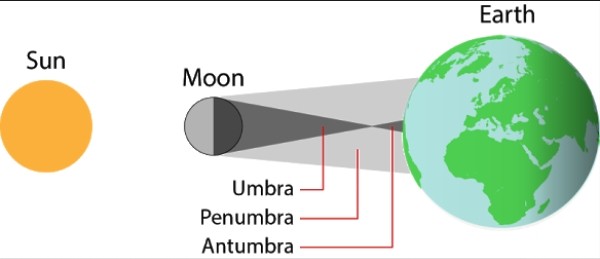On the 21st of this month of June, our planet Earth will witness the 3rd out of six (6) rounds of eclipses scheduled for the year 2020. The first two eclipses were lunar eclipses which occurred on January 10th and June 5th. They were both observed from Africa. The forthcoming will be a solar eclipse. The remaining three (3) will be: July 5th Lunar eclipse, November 30 Lunar eclipse and December 14 Solar eclipse.
WHAT IS A SOLAR ECLIPSE?
This occurs when the moon comes between the Sun and the Earth in such a way they become so aligned or almost aligned in a straight form. This results in some parts of the Earth to be partially of totally obscured from the rays of sunlight. Solar eclipses can as well be called “eclipse of the Sun” and it should be noted that it happens during new moon but not during all new moon.

Image showing during solar eclipse, the moon is between Earth and the Sun. Image credit: NASA
There are three (3) but four (4) types of solar eclipses:
Partial
Total
Annular
Hybrid

Image credit: national eclipse. com
Partial solar eclipse is the most recurring and can be seen alongside with each of the aforementioned three. It can occur alone. In such case there is no perfect alignment, so Earth transits along the diffuse shadow of the moon called the penumbra

Image showing what a partial solar eclipse typically looks like.
Image credit: Himal Bhandari from Nepal
Total solar eclipse is the most thrilling of all the solar eclipses. It occurs when the moon is in a perfect alignment and at its perigee to Earth. As a result of that, the Sun’s disk becomes completely blocked. Regions under the Umbra of the shadow of the moon experience total darkness, and as indicated earlier, regions of the world not under the umbra experiences partial solar eclipse (that is, penumbra). To have the best view of the Sun’s Corona, it is during total solar eclipse. It is not only the best but the only moment to do so. Note: Total solar eclipse occurs ones in every two years somewhere on Earth but any region of the Earth that has ever experienced it will encounter it again in the next 400 years counting from the year in occurred last there.

Image credit: TimeAndDate.com

Image credit: NASA
Annular solar eclipse is the second most spectacular after the total solar eclipse and second most frequent after partial solar eclipse. Like total solar eclipse, it occurs when the moon is on a perfect alignment, but this moment at Apogee. As a result of that, the Sun’s disk is not completely submerged by the moon’s disk. So regions that fall under the Antumbra see a ring of fire called Annualus in Greek while the region which fall under the penumbra see a Partial solar eclipse.


Hybrid Solar Eclipses for a given solar eclipse is the case where by some parts of the Earth perceives it as a total solar eclipse and other perceives it as an annular solar eclipse. This is as a result of the geometry of Earth. It is also called
Annular/Total solar eclipses. This kind of eclipse is the rarest of all. The last time such was experienced was on November 3, 2013.

On June 21 of this year, we will experience Annual solar eclipse across some parts of: Africa, South – East Europe, Asia and the Pacific.
Regions of the African continent that will come under path of Annularity are: Republic of Congo
Democratic republic of Congo. Central Africa republic
South Sudan
Sudan
Ethiopia
Eritrea
and Into the red sea and beyond.
Nearby countries to these aforementioned ones will experience ONLY partial solar eclipse (penumbra). Every other person can stream it live from this link.
Starting from the Republic of Congo, it will kickoff as a partial solar eclipse at 4:46 a.m (GMT + 1) and then Annular by 5:47 a.m (GMT + 1) an will then move to the East according as depicted on the map below.

Image credit: national eclipse. com
So if you are in or around these mapped locations and you do want to witness this event, you have to be on the guide from 04:46 a.m (GMT + 1), because for a given point it will last for less than 3 minutes. the whole event from Africa to Asia, from Penumbra to Annular and back to penumbra will last for 5hrs, 38 minutes.
SAFETY PRECAUTIONS
It is very dangerous to look at the sun with your naked eyes, binoculars or telescope. This Handbook and Posters (1, 2, 3, 4, 5, 6, 7) designed by the African Astronomical Society explains all about the eclipse and how to see it. A free android app on the eclipse has been developed by Alok Mandavgane for the Astronomical Society of India, and adapted for Africa.
Wishing you all a clear skies on June 21st



